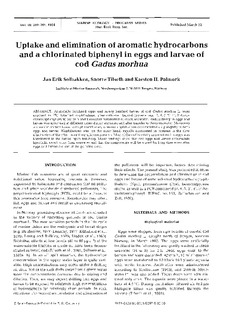Uptake and elimination of aromatic hydrocarbons a chlorinated biphenyl in eggs and larvae of cod Gadus morhua
| dc.contributor.author | Solbakken, Jan Erik | |
| dc.contributor.author | Tilseth, Snorre | |
| dc.contributor.author | Palmork, Karsten H. | |
| dc.date.accessioned | 2007-06-13T10:42:34Z | |
| dc.date.issued | 1984 | |
| dc.identifier.issn | 0171-8630 | |
| dc.identifier.uri | http://hdl.handle.net/11250/108631 | |
| dc.description.abstract | Artificially fertilized eggs and newly hatched larvae of cod Gadus rnorhua L. were exposed to 14C labelled naphthalene, phenanthrene, benzo(a)pyrene and 2. 4. 5. 2', 4', 5'-hexachlorobiphenyl (PCB) for 24 h and thereafter transferred to clean seawater. Radioactivity in eggs and larvae was measured at different times during exposure and after transfer to clean seawater. Maximum accumulation was found with phenanthrene, whereas naphthalene accumulated only slightly in both eggs and larvae. Naphthalene was, on the other hand, rapidly eliminated in contrast to the slow elimination of the other more lipophilic components. Most of the radioactivity accumulated in eggs was transferred to the larvae upon hatching. These findings show that cod eggs and larvae accumulate lipophilic xenobiotics from seawater and that the components will be stored for long time even after eggs and larvae are out of the polluted area. | en |
| dc.format.extent | 389018 bytes | |
| dc.format.mimetype | application/pdf | |
| dc.language.iso | eng | en |
| dc.subject | torsk | en |
| dc.subject | cod | en |
| dc.subject | forurensning | |
| dc.subject | pollution | |
| dc.title | Uptake and elimination of aromatic hydrocarbons a chlorinated biphenyl in eggs and larvae of cod Gadus morhua | en |
| dc.type | Journal article | en |
| dc.type | Peer reviewed | |
| dc.source.pagenumber | 297-301 | |
| dc.source.volume | 16 | |
| dc.source.journal | Marine Ecology Progress Series | |
| dc.identifier.doi | http://dx.doi.org/10.3354/meps016297 |
Files in this item
This item appears in the following Collection(s)
-
Articles [3001]
